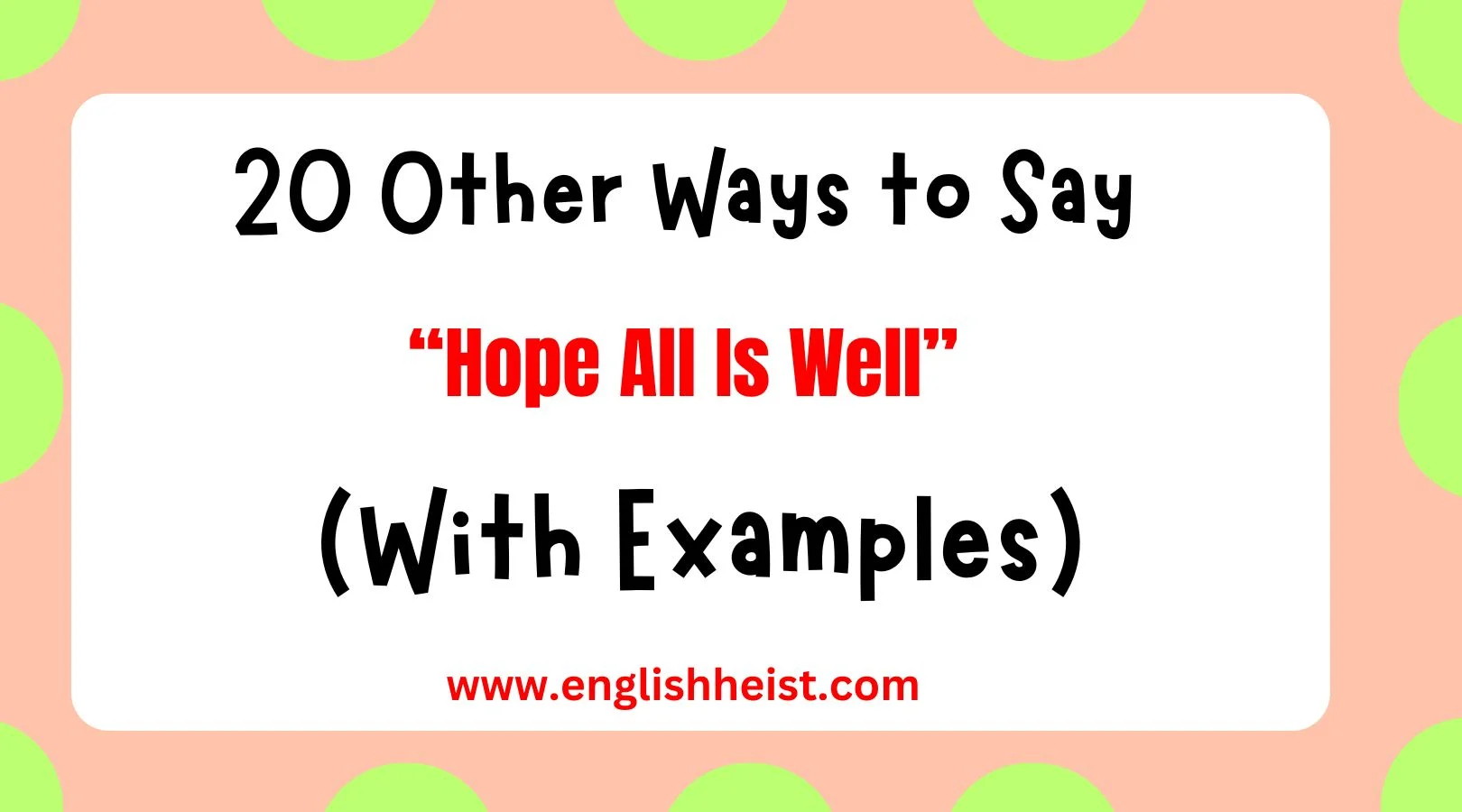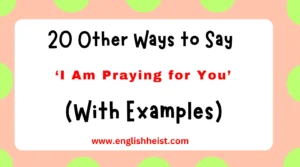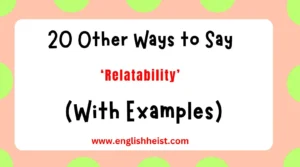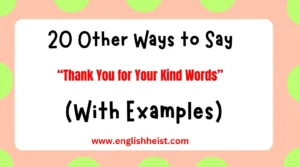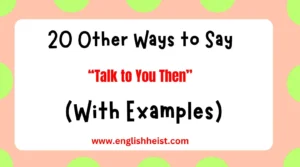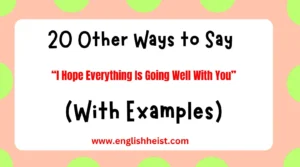Expressing well wishes is a fundamental part of communication, and “Hope all is well” is a classic phrase used to check in on someone. However, sometimes you might want to offer your sentiments in a more personal, creative, or thoughtful way. Whether you’re sending an email to a colleague, checking in on a friend, or reaching out to a loved one, there are plenty of alternatives to convey the same warmth and care. Here are 20 other ways to say “hope all is well” that can make your message feel more engaging and heartfelt.
What Does “Hope All Is Well” Mean?
“Hope all is well” is a polite and considerate way of expressing care and concern for someone’s well-being. It’s often used to check in with someone, whether you’re catching up after some time apart, or just wanting to show that you’re thinking of them. The phrase is versatile and can be used in both personal and professional contexts, though it leans toward a warmer, informal tone.
Is It Professional/Polite to Say “Hope All Is Well”?
Yes, “Hope all is well” is polite and appropriate for both professional and personal contexts. It’s a gentle and friendly way to inquire about someone’s well-being without being too intrusive. However, in more formal or business contexts, a slightly more structured phrase might be preferred, such as “I trust everything is going well.” It is generally warm, polite, and can be adjusted based on the relationship you have with the person.
Pros and Cons of Saying “Hope All Is Well”
Pros:
- Simple and polite: It’s easy to say and understood universally.
- Friendly and warm: It can be used in various situations to show care.
- Non-intrusive: It’s a gentle way of asking how someone is without prying too much.
Cons:
- Overused: Can sound generic if used too frequently.
- Lacks depth: Sometimes doesn’t go beyond a surface-level check-in.
Key Points to Remember:
- While “Hope all is well” is a go-to phrase, it can be more meaningful if you personalize your message.
- The tone and context matter—be mindful of the situation and the relationship you have with the recipient.
- If you want to convey more emotion or specificity, trying a different phrase can make your message feel more thoughtful and unique.
Synonyms For Hope All Is Well
- I Hope You’re Doing Well
- I Trust You’re Doing Well
- I Hope Everything Is Going Well for You
- I Hope You’re Having a Good Day
- I Hope You’re Doing Alright
- I Hope You’re Keeping Well
- I Hope You’re Feeling Good
- Hope You’re Doing Okay
- I Hope Life Is Treating You Well
- I Hope All Is Going Well for You
- I Trust Everything Is Going Smoothly
- I Hope Things Are Going Great for You
- I Hope You’re Staying Safe
- I Hope You’re Doing Well, All Things Considered
- I Hope You’re Doing Better
- I Hope Everything Is Looking Up
- Just Checking In to See How You Are
- Wishing You Well
- I Hope You’re Having a Wonderful Week
- Sending You Positive Thoughts
1. “I Hope You’re Doing Well”
Scenario: When you want to inquire about someone’s general well-being.
Examples:
- “I hope you’re doing well and things are going smoothly for you.”
- “Just checking in—I hope you’re doing well.”
- “I hope you’re doing well these days!”
Best Use: For casual or friendly check-ins.
Tone: Warm, caring.
Explanation: A gentle way of expressing concern for someone’s overall state, without being too specific.
2. “I Trust You’re Doing Well”
Scenario: A more formal and respectful way of checking in.
Examples:
- “I trust you’re doing well and that everything is going smoothly.”
- “I trust you’re doing well and adjusting to the changes.”
- “I hope you’re doing well and thriving.”
Best Use: In professional or semi-formal settings.
Tone: Polite, professional.
Explanation: A more refined version of checking in, often used in business or professional communications.
3. “I Hope Everything Is Going Well for You”
Scenario: A slightly more detailed check-in.
Examples:
- “I hope everything is going well for you these days.”
- “I trust everything is going well for you—please let me know if you need anything.”
- “I hope everything is going well with your project!”
Best Use: When you want to sound a bit more involved or specific.
Tone: Warm, considerate.
Explanation: This phrase conveys a bit more personal interest than just “hope all is well.”
4. “I Hope You’re Having a Good Day”
Scenario: A quick check-in that is positive and lighthearted.
Examples:
- “I hope you’re having a good day so far!”
- “I just wanted to reach out and hope you’re having a great day!”
- “I hope you’re having a good day and everything is going smoothly.”
Best Use: Best when sending quick messages throughout the day.
Tone: Casual, cheerful.
Explanation: It’s a friendly way to show you care about the person’s current state.
5. “I Hope You’re Doing Alright”
Scenario: When you want to acknowledge that someone may be going through a tough time.
Examples:
- “I hope you’re doing alright, let me know if you need to talk.”
- “I hope you’re doing alright these days, it’s been a while.”
- “I know things have been difficult lately, but I hope you’re doing alright.”
Best Use: When you suspect someone might need a little extra care or attention.
Tone: Empathetic, gentle.
Explanation: This phrase is especially useful when you are concerned that the person may not be doing well.
6. “I Hope You’re Keeping Well”
Scenario: Another way to check in on someone’s health and well-being.
Examples:
- “I hope you’re keeping well and staying safe.”
- “I hope you’re keeping well and handling everything okay.”
- “Sending you best wishes—I hope you’re keeping well!”
Best Use: Ideal for both professional and personal messages.
Tone: Polite, thoughtful.
Explanation: This expression is formal but friendly and suitable for professional or personal interactions.
7. “I Hope You’re Feeling Good”
Scenario: When you want to check on someone’s physical or emotional state.
Examples:
- “I hope you’re feeling good today!”
- “I trust you’re feeling good and in good spirits.”
- “I hope you’re feeling good and energized!”
Best Use: Perfect for friends or loved ones, especially when you know they’ve had health issues.
Tone: Casual, caring.
Explanation: It’s a way to specifically address someone’s health and mood in a friendly, casual manner.
8. “Hope You’re Doing Okay”
Scenario: When you want to check in without prying too much.
Examples:
- “I hope you’re doing okay, just wanted to check in.”
- “Hope you’re doing okay after everything that’s happened.”
- “I know things have been tough, hope you’re doing okay.”
Best Use: When you suspect someone might be having a rough time.
Tone: Empathetic, supportive.
Explanation: A softer, less intrusive way to express concern for someone’s well-being.
9. “I Hope Life Is Treating You Well”
Scenario: A slightly more poetic way to ask about someone’s overall state.
Examples:
- “I hope life is treating you well and you’re happy!”
- “I hope life is treating you well these days!”
- “Sending you positive vibes, I hope life is treating you well!”
Best Use: Great for expressing care in personal communications.
Tone: Warm, thoughtful.
Explanation: This phrase feels a bit more unique and can stand out from other, more generic ways of checking in.
10. “I Hope All Is Going Well for You”
Scenario: Another way to ask if things are going smoothly for someone.
Examples:
- “I hope all is going well for you and your family.”
- “Just checking in—I hope all is going well for you.”
- “I hope all is going well with your new project!”
Best Use: Suitable for both formal and informal messages.
Tone: Neutral, friendly.
Explanation: A more neutral option, suitable for professional and personal contexts alike.
11. “I Trust Everything Is Going Smoothly”
Scenario: A formal and professional check-in.
Examples:
- “I trust everything is going smoothly on your end.”
- “I hope you’re doing well and that everything is going smoothly for you.”
- “I trust that everything is progressing smoothly with the project.”
Best Use: Best used in business or professional contexts.
Tone: Formal, courteous.
Explanation: This phrase works well when you want to maintain a polite and professional tone while still showing care.
12. “I Hope Things Are Going Great for You”
Scenario: When you want to check in and add a little more enthusiasm.
Examples:
- “I hope things are going great for you—let me know how you’re doing!”
- “Just wanted to say I hope things are going great for you!”
- “Hope everything is going great—looking forward to hearing from you!”
Best Use: Great for friends or colleagues you have a positive relationship with.
Tone: Cheerful, enthusiastic.
Explanation: This phrase conveys optimism and positive vibes, making it ideal for people you’re excited to hear from.
13. “I Hope You’re Staying Safe”
Scenario: Useful when safety or well-being is your main concern.
Examples:
- “I hope you’re staying safe during these times!”
- “Just wanted to check in and make sure you’re staying safe!”
- “I hope you and your loved ones are staying safe and healthy.”
Best Use: Perfect during uncertain or challenging times, such as during a pandemic or in adverse situations.
Tone: Concerned, caring.
Explanation: This phrase adds an element of concern for someone’s safety, making it feel more personal.
14. “I Hope You’re Doing Well, All Things Considered”
Scenario: When someone is going through a difficult time, and you want to acknowledge that.
Examples:
- “I hope you’re doing well, all things considered—let me know if you need anything.”
- “I hope you’re doing okay, all things considered.”
- “Given everything that’s happening, I hope you’re doing well.”
Best Use: When someone is going through a hard time, but you still want to offer encouragement.
Tone: Empathetic, thoughtful.
Explanation: A more considerate way to acknowledge difficulties while still wishing the best for the person.
Read More: 20 Other Ways to Say “Thinking of You” (With Examples)
15. “I Hope You’re Doing Better”
Scenario: When you know someone has been struggling and want to express hope for their improvement.
Examples:
- “I hope you’re doing better today!”
- “I hope you’re doing better since our last chat.”
- “Sending good thoughts your way, hope you’re doing better!”
Best Use: Ideal when checking in on someone who’s been under the weather or facing challenges.
Tone: Gentle, supportive.
Explanation: This phrase conveys care and empathy for someone who has faced difficulties.
16. “I Hope Everything Is Looking Up”
Scenario: When you’re hoping for a positive change or improvement in someone’s life.
Examples:
- “I hope everything is looking up for you after the rough patch.”
- “It sounds like things have been challenging—I hope everything is looking up soon.”
- “Wishing you all the best, and I hope everything is looking up!”
Best Use: When checking in on someone who has been going through a tough time and you want to offer encouragement.
Tone: Optimistic, supportive.
Explanation: This phrase conveys hope that things are improving and expresses optimism for the recipient’s situation.
17. “Just Checking In to See How You Are”
Scenario: A simple and direct way to ask about someone’s well-being in a caring manner.
Examples:
- “Just checking in to see how you are—hope all is going well!”
- “Hey, it’s been a while! Just checking in to see how you’ve been.”
- “I was thinking about you and just checking in to see how you are.”
Best Use: Great for reconnecting with friends, family, or colleagues after some time apart.
Tone: Friendly, warm.
Explanation: This phrase removes formality and makes it clear that you genuinely care about the person’s well-being.
18. “Wishing You Well”
Scenario: A polite and professional way to send good wishes, especially when you may not be able to check in further.
Examples:
- “Wishing you well and hoping everything is going great for you!”
- “Just wanted to reach out and say I’m wishing you well.”
- “Wishing you well—hope to catch up soon!”
Best Use: Suitable for professional, semi-formal, or personal messages when you want to keep it short yet thoughtful.
Tone: Polite, warm.
Explanation: This phrase is commonly used in both emails and casual messages, offering good intentions without expecting a response.
19. “I Hope You’re Having a Wonderful Week”
Scenario: A more specific way to check in by acknowledging the person’s current timeframe.
Examples:
- “I hope you’re having a wonderful week so far!”
- “Just wanted to say hi and hope you’re having a wonderful week.”
- “Hope your week is going well—take care!”
Best Use: Perfect for mid-week check-ins, whether professional or personal.
Tone: Cheerful, uplifting.
Explanation: By specifying “week,” it feels more timely and natural, making it an excellent way to casually check in.
20. “Sending You Positive Thoughts”
Scenario: When you want to express warmth and encouragement, especially during difficult times.
Examples:
- “Just thinking of you and sending you positive thoughts.”
- “I know things have been tough—sending you positive thoughts and good energy!”
- “Whatever you’re going through, I’m sending you positive thoughts and hope things get better.”
Best Use: When offering support or motivation to someone who may need a little extra encouragement.
Tone: Encouraging, heartfelt.
Explanation: This phrase is a more emotional and thoughtful way to show you care, making it perfect for supporting friends, family, or colleagues in difficult situations.
Conclusion
Finding the right words to express care and concern can make a big difference in how your message is received. While “Hope all is well” is a polite and commonly used phrase, choosing more personalized alternatives can help strengthen connections and make your communication feel more meaningful.
Whether you’re checking in on a friend, sending a professional email, or offering support to someone going through a tough time, the right phrase can set the tone and show your sincerity.

Emma Rose is your ultimate guide to mastering English. With practical lessons, expert tips, and engaging content, Emma makes learning grammar, vocabulary, and writing skills simple and enjoyable. Whether you’re a beginner or looking to refine your language skills, English Heist helps you communicate with confidence.
